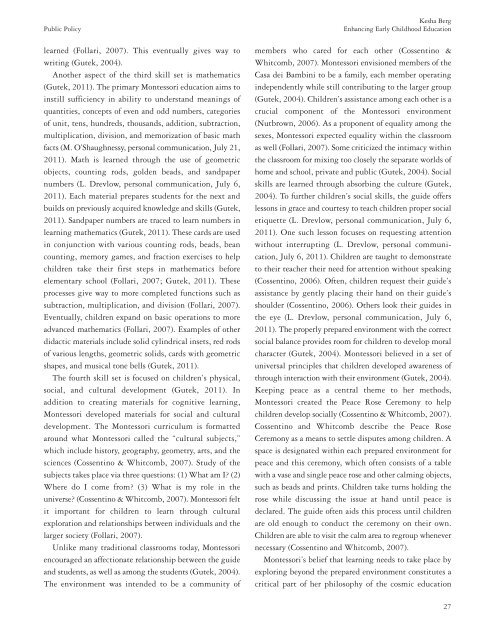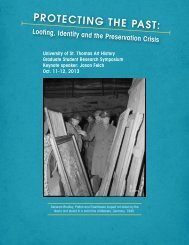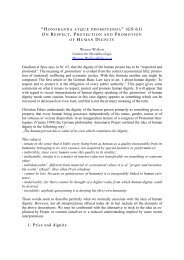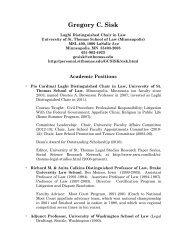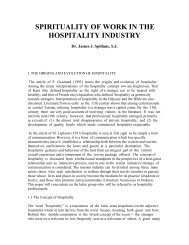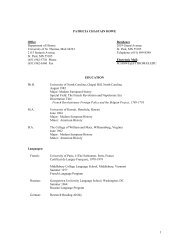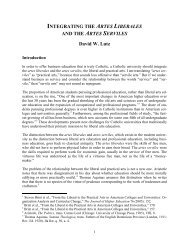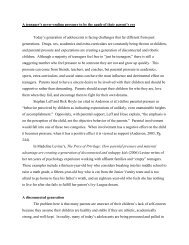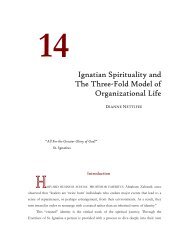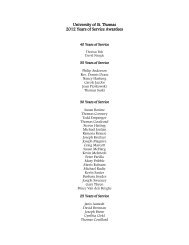dr. ronald e. mcnair acknowledgements - University of St. Thomas
dr. ronald e. mcnair acknowledgements - University of St. Thomas
dr. ronald e. mcnair acknowledgements - University of St. Thomas
You also want an ePaper? Increase the reach of your titles
YUMPU automatically turns print PDFs into web optimized ePapers that Google loves.
Kesha Berg<br />
Public Policy Enhancing Early Childhood Education<br />
learned (Follari, 2007). This eventually gives way to<br />
writing (Gutek, 2004).<br />
Another aspect <strong>of</strong> the third skill set is mathematics<br />
(Gutek, 2011). The primary Montessori education aims to<br />
instill sufficiency in ability to understand meanings <strong>of</strong><br />
quantities, concepts <strong>of</strong> even and odd numbers, categories<br />
<strong>of</strong> unit, tens, hun<strong>dr</strong>eds, thousands, addition, subtraction,<br />
multiplication, division, and memorization <strong>of</strong> basic math<br />
facts (M. O’Shaughnessy, personal communication, July 21,<br />
2011). Math is learned through the use <strong>of</strong> geometric<br />
objects, counting rods, golden beads, and sandpaper<br />
numbers (L. Drevlow, personal communication, July 6,<br />
2011). Each material prepares students for the next and<br />
builds on previously acquired knowledge and skills (Gutek,<br />
2011). Sandpaper numbers are traced to learn numbers in<br />
learning mathematics (Gutek, 2011). These cards are used<br />
in conjunction with various counting rods, beads, bean<br />
counting, memory games, and fraction exercises to help<br />
chil<strong>dr</strong>en take their first steps in mathematics before<br />
elementary school (Follari, 2007; Gutek, 2011). These<br />
processes give way to more completed functions such as<br />
subtraction, multiplication, and division (Follari, 2007).<br />
Eventually, chil<strong>dr</strong>en expand on basic operations to more<br />
advanced mathematics (Follari, 2007). Examples <strong>of</strong> other<br />
didactic materials include solid cylin<strong>dr</strong>ical insets, red rods<br />
<strong>of</strong> various lengths, geometric solids, cards with geometric<br />
shapes, and musical tone bells (Gutek, 2011).<br />
The fourth skill set is focused on chil<strong>dr</strong>en’s physical,<br />
social, and cultural development (Gutek, 2011). In<br />
addition to creating materials for cognitive learning,<br />
Montessori developed materials for social and cultural<br />
development. The Montessori curriculum is formatted<br />
around what Montessori called the “cultural subjects,”<br />
which include history, geography, geometry, arts, and the<br />
sciences (Cossentino & Whitcomb, 2007). <strong>St</strong>udy <strong>of</strong> the<br />
subjects takes place via three questions: (1) What am I? (2)<br />
Where do I come from? (3) What is my role in the<br />
universe? (Cossentino & Whitcomb, 2007). Montessori felt<br />
it important for chil<strong>dr</strong>en to learn through cultural<br />
exploration and relationships between individuals and the<br />
larger society (Follari, 2007).<br />
Unlike many traditional classrooms today, Montessori<br />
encouraged an affectionate relationship between the guide<br />
and students, as well as among the students (Gutek, 2004).<br />
The environment was intended to be a community <strong>of</strong><br />
members who cared for each other (Cossentino &<br />
Whitcomb, 2007). Montessori envisioned members <strong>of</strong> the<br />
Casa dei Bambini to be a family, each member operating<br />
independently while still contributing to the larger group<br />
(Gutek, 2004). Chil<strong>dr</strong>en’s assistance among each other is a<br />
crucial component <strong>of</strong> the Montessori environment<br />
(Nutbrown, 2006). As a proponent <strong>of</strong> equality among the<br />
sexes, Montessori expected equality within the classroom<br />
as well (Follari, 2007). Some criticized the intimacy within<br />
the classroom for mixing too closely the separate worlds <strong>of</strong><br />
home and school, private and public (Gutek, 2004). Social<br />
skills are learned through absorbing the culture (Gutek,<br />
2004). To further chil<strong>dr</strong>en’s social skills, the guide <strong>of</strong>fers<br />
lessons in grace and courtesy to teach chil<strong>dr</strong>en proper social<br />
etiquette (L. Drevlow, personal communication, July 6,<br />
2011). One such lesson focuses on requesting attention<br />
without interrupting (L. Drevlow, personal communi -<br />
cation, July 6, 2011). Chil<strong>dr</strong>en are taught to demonstrate<br />
to their teacher their need for attention without speaking<br />
(Cossentino, 2006). Often, chil<strong>dr</strong>en request their guide’s<br />
assistance by gently placing their hand on their guide’s<br />
shoulder (Cossentino, 2006). Others look their guides in<br />
the eye (L. Drevlow, personal communication, July 6,<br />
2011). The properly prepared environment with the correct<br />
social balance provides room for chil<strong>dr</strong>en to develop moral<br />
character (Gutek, 2004). Montessori believed in a set <strong>of</strong><br />
universal principles that chil<strong>dr</strong>en developed awareness <strong>of</strong><br />
through interaction with their environment (Gutek, 2004).<br />
Keeping peace as a central theme to her methods,<br />
Montessori created the Peace Rose Ceremony to help<br />
chil<strong>dr</strong>en develop socially (Cossentino & Whitcomb, 2007).<br />
Cossentino and Whitcomb describe the Peace Rose<br />
Ceremony as a means to settle disputes among chil<strong>dr</strong>en. A<br />
space is designated within each prepared environment for<br />
peace and this ceremony, which <strong>of</strong>ten consists <strong>of</strong> a table<br />
with a vase and single peace rose and other calming objects,<br />
such as beads and prints. Chil<strong>dr</strong>en take turns holding the<br />
rose while discussing the issue at hand until peace is<br />
declared. The guide <strong>of</strong>ten aids this process until chil<strong>dr</strong>en<br />
are old enough to conduct the ceremony on their own.<br />
Chil<strong>dr</strong>en are able to visit the calm area to regroup whenever<br />
necessary (Cossentino and Whitcomb, 2007).<br />
Montessori’s belief that learning needs to take place by<br />
exploring beyond the prepared environment constitutes a<br />
critical part <strong>of</strong> her philosophy <strong>of</strong> the cosmic education<br />
27


